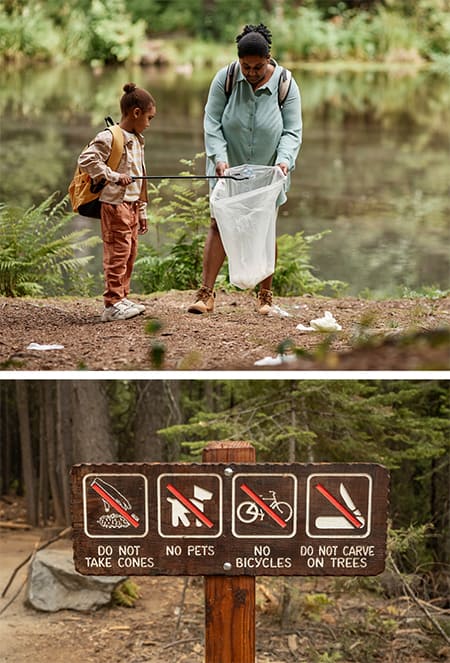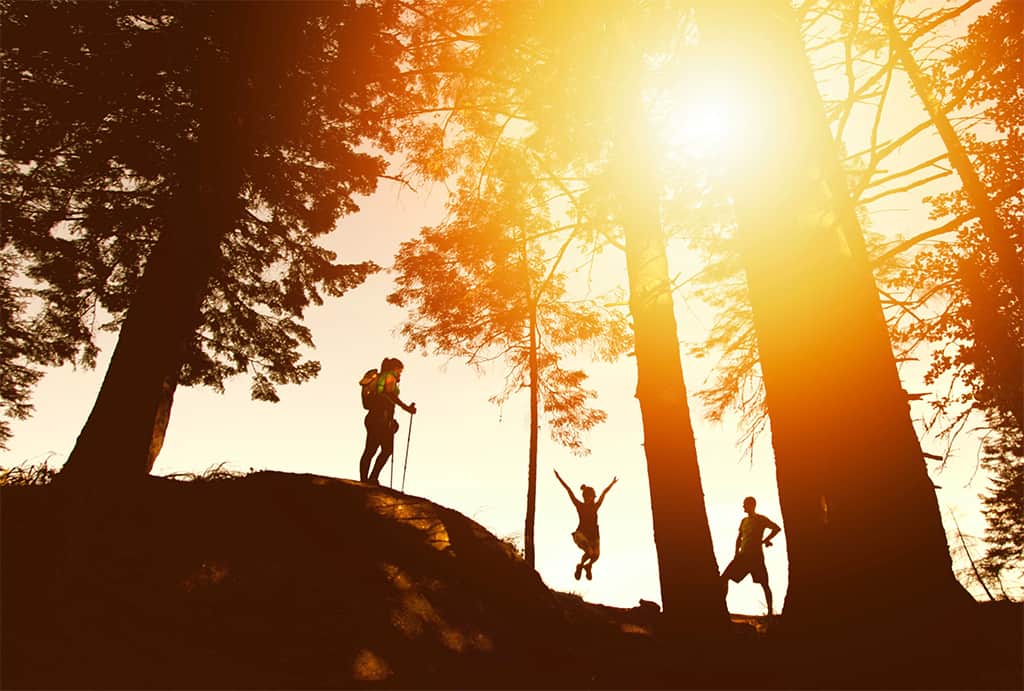
Excited about hitting the trails this summer? As with so many things in life, the right preparation is key.
Hiking is, hands down, one of the best activities out there: healthy for mind and body alike, offering near-infinite variety, and containing vast opportunity for bonding with family, friends, dogs, and miscellaneous higher powers of all descriptions.
Excited about hitting the trails this summer? As with so many things in life, the right preparation is key. We want you to come home from every excursion happy (if exhausted), having had the best day ever and eager for next time. To that end, read on to learn what you need to know.
We’d be remiss to not offer thanks to Trailkeeper, a fabulous source of outdoor guidance, and especially to Sullivan County Trailkeeper for equipment tips.
HIKING EQUIPMENT
Heading onto the trail in cutoffs and flip flops is a recipe for mosquito bites, sore feet, and sunburn. You don’t need to outfit like an Alpine climber to have a lot of fun in the Catskills and the Hudson Valley, but you do need a few good basics to ensure comfort, health, and safety.
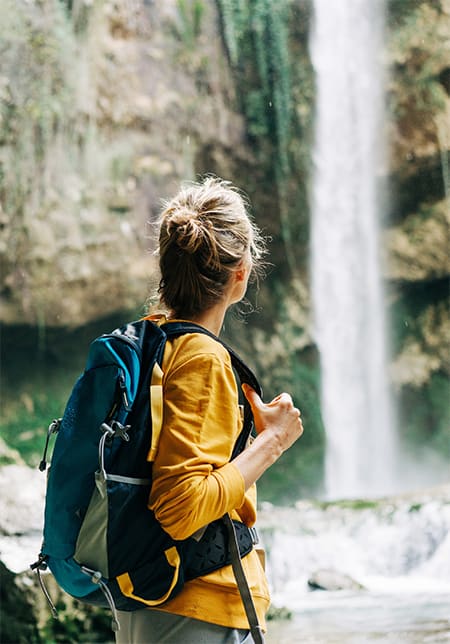
You don’t need to outfit like an Alpine climber to have a lot of fun in the Catskills and the Hudson Valley, but you do need a few good basics to ensure comfort, health, and safety.

BOOTS
Happy feet make for happy hikes. To get the right boots, consider what kind of trails you want to conquer and what matters most to you. Materials matter. Leather is sturdy, heavy, and somewhat water-resistant. It does take longer to break in, so don’t attempt a 10-mile mountain expedition the first day you wear them. Synthetics break in faster, are lighter, and usually cost less. You may find they wear out faster, so it depends on your priorities. Unless wading is a big part of the plan (and wading can be wonderful!) don’t try to go waterproof. It’s also air-proof, meaning your feet will get hot and sweaty on dry land. For shorter, easier hikes, you’ll want a low or mid-rise boot. If you’re heading up a serious mountain or planning to bushwhack through brush, mid or high is the way to go for better ankle support and greater protection. Make sure the fit is perfect, keeping your foot right where it belongs—having your toes bumping into the front of your boot, your heel sliding around, or a pinchy place may seem like no big deal in the store, but it’ll become a very big deal indeed after the first couple of miles. Wear your hiking socks to try them on, and take a good little walk around the store, not three paces.
SOCKS
Avoid cotton. It traps moisture. Choose a good merino wool if you want organic fiber, or check out the nifty synthetics that are designed to wick moisture away from your skin.
CLOTHING
Most public places, even thickly forested ones, will take a dim view of hikers showing up in just boots and socks. The good news is, just about anything you own that’s comfy and warm or cool enough will be fine. Layers are the key to all-weather comfort. In summer, that means an inner layer that wicks sweat away from your skin and a lightweight, but water- and wind-proof, outer layer in your pack in case it turns cool or rainy. Long, loose, light-colored pants are great protection from scratchy brush and—more importantly—ticks. You can get the zip-apart kind and convert them to shorts when you’re out of the undergrowth.
ACCESSORIES
The lovely thing about hiking is how little you really need. A pack that will hold your lunch, water bottle, and windbreaker is really about it, although a lot of people like to carry a walking stick or trekking pole to help navigate rough terrain. Choose the right size pack. Big camping ones will get annoyingly burdensome on a day hike.
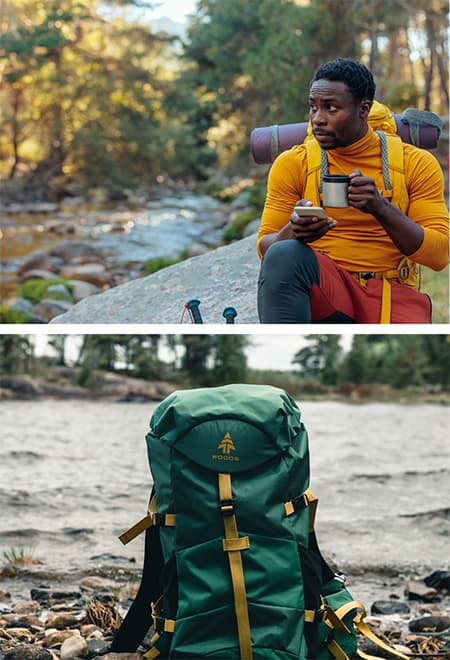
A smaller daypack should hold both the essentials mentioned above and a journal, sketchbook, insect repellent, and sunscreen. Toss a whistle and a flashlight in there if there’s even a slight chance of getting lost, delayed, or injured. It’s a whole lot easier to blow a whistle for help than to yell over and over. The shoulder straps of your pack should be padded and wide, not pinchy and cutting into you. Straps for your hips and/or chest will offer better weight distribution and comfort. Look for well-stitched seams, durable fabric, and at least a couple of outer pockets to keep, say, your water bottle in easy reach, plus an inner pocket that will keep things like keys and wallet orderly and secure. Wear sunglasses and a sun hat: Your eyes and hair will thank you.
HIKING ETIQUETTE
The woods might be a lot less people-y than the sidewalks, but the people who are there deserve full consideration—as do the native critters and plants who are sharing their space with you. Mastering a few time-tested guidelines will make you a good citizen of the forest instead of the main character in someone else’s horror tale..
KNOW YOUR RIGHT OF WAY RULES: On multi-use trails, horses and bicycles have right of way. As on the road, keep to your right so people have room to pass on the left. People headed uphill have the right of way over those headed down. Give a polite word of warning if you’re about to pass someone who seems unaware of you; pay attention to those who need to pass you and grant them as much room as you can.
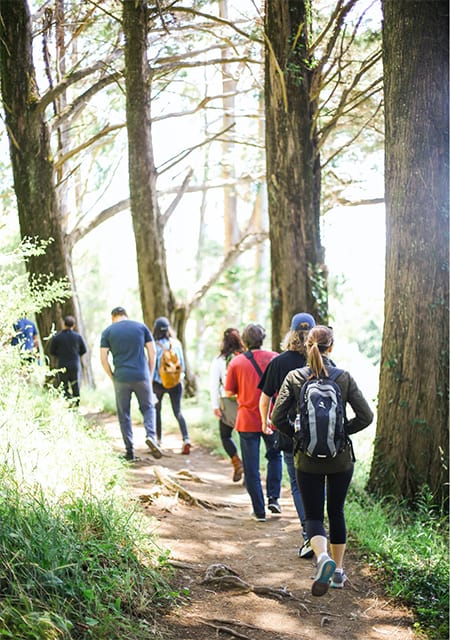
KEEP THE WOODS PEACEFUL: Talking quietly isn’t just a kindness to any other people and animals around, it also maximizes your chances of glimpsing wild critters. Put your cell phone on vibrate, or just turn it off. Skip the music, and listen to the birds and the breezes. If you have a big group, all of this peaceful stuff will just be easier to maintain if you split up into smaller groups of three or four. Saying hi to people you encounter is basic good manners out here—so is warning them of an upcoming mud hole or downed tree. Besides making for a friendlier forest, this precaution means that you’ll remember having seen each other and can aid rescuers should any of you suffer misfortune.
…AND CLEAN: Tuck a bag into your backpack that you’ll use not just to pack out trash of your own, but to collect any trash you find. If you see major dumping or vandalism, report the location to whichever agency is in charge of the land you’re on.
MIND THE RULES: If fires or dogs aren’t allowed, leave the matches and the pup at home. If they say “no motorized vehicles,” they mean it. Don’t fish or hunt without a license or out of season; it’s unkind to wildlife, and if a ranger spots you, you will probably face arrest and a hefty fine. If camping is part of the plan, make sure it’s allowed. If you’re wilderness camping, camp off the trail on a level, solid patch, and take care not to squish the vegetation. Keep your privy-hole (aka outdoor latrine) at least 100 feet away from streams or lakeshores.
MOST OF ALL, BE KIND TO EVERYTHING AND EVERYONE. Avoid any unnecessary breaking of branches or digging of holes, and don’t dam up the stream “for fun.” It might seem fun to you, but a lot less so to any reptiles, fish, or amphibians that are just trying to raise families there. If you’re given a chance to help another hiker, take it. Know the trail and share your info, even your food and water if someone’s in a bad way. We’re all guests of Mama Nature in these fine forests—make sure that, if she had a voice, she’d be inviting you to come back anytime.
